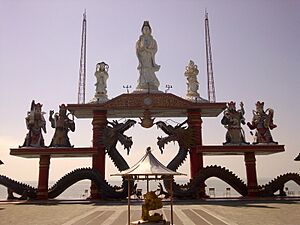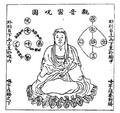Guanyin facts for kids
Quick facts for kids Guanyin |
|||||||||||||||||||||||||||||||||
|---|---|---|---|---|---|---|---|---|---|---|---|---|---|---|---|---|---|---|---|---|---|---|---|---|---|---|---|---|---|---|---|---|---|

|
|||||||||||||||||||||||||||||||||
| Chinese name | |||||||||||||||||||||||||||||||||
| Traditional Chinese | 觀音 | ||||||||||||||||||||||||||||||||
| Simplified Chinese | 观音 | ||||||||||||||||||||||||||||||||
|
|||||||||||||||||||||||||||||||||
| Full Chinese name | |||||||||||||||||||||||||||||||||
| Traditional Chinese | 觀世音 | ||||||||||||||||||||||||||||||||
| Simplified Chinese | 观世音 | ||||||||||||||||||||||||||||||||
| Literal meaning | "[The One Who] Perceives the Sounds of the World" | ||||||||||||||||||||||||||||||||
|
|||||||||||||||||||||||||||||||||
| Second alternative Chinese name | |||||||||||||||||||||||||||||||||
| Traditional Chinese | 觀自在 | ||||||||||||||||||||||||||||||||
| Simplified Chinese | 观自在 | ||||||||||||||||||||||||||||||||
| Literal meaning | "Lord who Gazes down on the World" | ||||||||||||||||||||||||||||||||
|
|||||||||||||||||||||||||||||||||
| Burmese name | |||||||||||||||||||||||||||||||||
| Burmese | ကွမ်ယင် | ||||||||||||||||||||||||||||||||
| IPA | [kwàɴ jɪ̀ɴ] | ||||||||||||||||||||||||||||||||
| Tibetan name | |||||||||||||||||||||||||||||||||
| Tibetan | སྤྱན་རས་གཟིགས | ||||||||||||||||||||||||||||||||
| Vietnamese name | |||||||||||||||||||||||||||||||||
| Vietnamese alphabet | Quan Âm (Quán Âm) Quán Thế Âm (Quan Thế Âm) Quán Tự Tại |
||||||||||||||||||||||||||||||||
| Chữ Hán | 觀音 觀世音 觀自在 |
||||||||||||||||||||||||||||||||
| Thai name | |||||||||||||||||||||||||||||||||
| Thai | กวนอิม, พระอวโลกิเตศวรโพธิสัตว์ | ||||||||||||||||||||||||||||||||
| RTGS | Kuan Im, Phra Avalokitesuan | ||||||||||||||||||||||||||||||||
| Korean name | |||||||||||||||||||||||||||||||||
| Hangul | 관음, 관세음, 관자재 | ||||||||||||||||||||||||||||||||
| Hanja | 觀音, 觀世音, 觀自在 | ||||||||||||||||||||||||||||||||
|
|||||||||||||||||||||||||||||||||
| Mongolian name | |||||||||||||||||||||||||||||||||
| Mongolian script | ᠨᠢᠳᠦ ᠪᠡᠷ ᠦᠵᠡᠭᠴᠢ |
||||||||||||||||||||||||||||||||
| Japanese name | |||||||||||||||||||||||||||||||||
| Kanji | 観音, 観世音, 観自在 | ||||||||||||||||||||||||||||||||
| Hiragana | かんのん, かんぜおん, かんじざい | ||||||||||||||||||||||||||||||||
|
|||||||||||||||||||||||||||||||||
| Indonesian name | |||||||||||||||||||||||||||||||||
| Indonesian | Kwan Im, Kwan She Im, Awalokiteswara | ||||||||||||||||||||||||||||||||
| Filipino name | |||||||||||||||||||||||||||||||||
| Tagalog | Guanyin (ᜄᜓᜀᜈᜌᜒᜈ) | ||||||||||||||||||||||||||||||||
| Sanskrit name | |||||||||||||||||||||||||||||||||
| Sanskrit | अवलोकितेश्वर (Avalokiteśvara) | ||||||||||||||||||||||||||||||||
| Khmer name | |||||||||||||||||||||||||||||||||
| Khmer | អវលោកិតេស្វរៈ (Avalokitesvarak), អវលោកេស្វរៈ (Avalokesvarak), លោកេស្វរៈ (Lokesvarak) | ||||||||||||||||||||||||||||||||
| Hmong name | |||||||||||||||||||||||||||||||||
| Hmong | Kabyeeb, Niam-Txiv Kabyeeb, Dabpog, Niam-Txiv Dabpog | ||||||||||||||||||||||||||||||||
Guanyin (traditional Chinese: 觀音; simplified Chinese: 观音; pinyin: Guānyīn) is a special being in Buddhism known as a Bodhisattva. A Bodhisattva is someone who has reached a very high level of spiritual understanding but chooses to stay in the world to help others. Guanyin is linked to compassion, which means deep kindness and caring for others.
She is the East Asian version of a Bodhisattva named Avalokiteśvara. Many people in Eastern religions, including Chinese folk religion, also follow her. Jesuit missionaries in China first called her the "Goddess of Mercy." Guanyin is a shorter name for Guanshiyin, which means "The One Who Hears the Sounds of the World." This name shows her role in listening to people's prayers. Every year, on the 19th day of the sixth lunar month, Buddhists celebrate the day Guanyin became a Buddha.
Some Buddhists believe that when people pass away, Guanyin places them in a lotus flower. Then, she sends them to a peaceful place called the western pure land of Sukhāvatī. Guanyin is often called the "most loved Buddhist Divinity." People believe she has amazing powers to help anyone who prays to her. This is written in important Buddhist texts like the Pumen chapter of the Lotus Sutra.
Many large temples in East Asia are dedicated to Guanyin. These include famous places like Shaolin Monastery in China and Kiyomizu-dera in Japan. In India, Guanyin's special home was said to be on Mount Potalaka. As belief in Guanyin spread, different areas chose their own "Potalaka" mountains. For example, in Chinese Buddhism, Mount Putuo is seen as Guanyin's sacred mountain. Naksansa is her Potalaka in Korea, and Fudarakusan-ji is Japan's. The Potala Palace in Tibet is also linked to her.
There are many pilgrimage sites for Guanyin in East Asia. Putuoshan is the main one in China. In Korea, there is a pilgrimage to 33 temples dedicated to Guanyin. Japan also has several Guanyin pilgrimages, with the Saigoku Kannon Pilgrimage being the oldest. Guanyin is respected by most Buddhist groups and is found in many Tibetan temples as Chenrézik. She is also worshipped in temples in Nepal, Sri Lanka, Thailand, and Burma. Statues of Guanyin are very common in Asian art and can be seen in museums worldwide.
Contents
Understanding Guanyin's Names
Guanyin's name comes from the Sanskrit word Avalokitasvara. This means "the one who looks down upon sound" or "sound perceiver." It refers to her ability to hear the cries of all living beings who need help. Early translators in China used the name Guanyin or Guanshiyin, which means "who perceives the world's lamentations." This shows how closely her name is tied to her compassionate nature.
Later, the name Avalokiteśvara became more common. This name means "Lord who Gazes down on the World." Even though the Sanskrit names changed a bit over time, the meaning of Guanyin as a compassionate helper stayed the same.
Guanyin's Names in Other Asian Countries

Because Guanyin is so popular across Asia, she is known by many different names. Most of these are just local ways of saying "Guanyin" or "Guanshiyin."
- In Cantonese, she is called G(w)ūn Yām or Kwun Yam.
- In Hokkien, she is Kuan Im or Kuan Se Im.
- In Japanese, she is Kannon or Kanzeon. The camera company Canon Inc. was even named after Kannon!
- In Korean, she is Gwan-eum or Gwanse-eum.
- In Vietnamese, she is Quan Âm or Quan Thế Âm.
- In Thai, she is Kuan Im or Phra Mae Kuan Im (Goddess Mother Kuan Im).
- In Tibetan, she is known as Chenrézik.
How Guanyin is Shown in Art
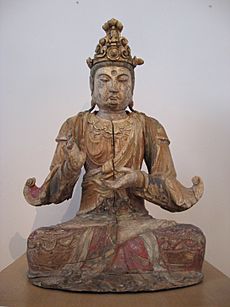
The Lotus Sutra is one of the oldest texts that talks about Avalokiteśvara (Guanyin). It says that Guanyin is a kind Bodhisattva who hears everyone's cries and works hard to help them. The Sutra explains that Guanyin can appear in many different forms. She can look like a god, a king, a man, a woman, an adult, or a child. This is so she can teach and help all kinds of beings.
Originally, Avalokiteśvara was shown as a male Bodhisattva, sometimes even with a light mustache. But over time, especially in China, Guanyin became more often shown as a woman. This is because she represents compassion and kindness, like a mother. Some people also believe Guanyin has no specific gender, or can be both male and female. This fits the idea that she can change her form to help anyone.
In Chinese art, Guanyin is usually shown as a beautiful young woman wearing a flowing white robe. She often has necklaces like royalty. In her left hand, she holds a jar of pure water, and in her right, a willow branch. The water can relieve suffering, and the willow branch is used to sprinkle it. Her crown often shows an image of Amitābha, who is her teacher.
There are also different ways Guanyin is shown depending on the region. For example, in Fujian, China, she might be shown as a maiden carrying a fish basket. This links to her role as a protector of fishermen.
Guanyin is often shown alone, or sometimes standing on a Chinese dragon. She might also be with two children, Longnü (a dragon girl) and Shancai (a boy). These children became her helpers after she helped them. Sometimes, she is shown with two warriors, Guan Yu and Skanda, who protect temples and the Buddhist faith. In some Buddhist traditions, Guanyin is part of a group called the "Three Saints of the West" with Buddha Amitābha and Bodhisattva Mahasthamaprapta.
Different Forms of Guanyin
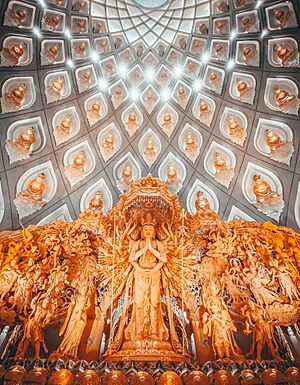
The Lotus Sutra describes 33 different forms Guanyin can take to help others. These forms include a Buddha, a king, a general, or even a child. This shows her power to adapt to any situation to bring salvation.
Guanyin also has six special forms, each linked to a different realm of existence in Buddhism:
- Great Mercy Guanyin: Helps those in the hungry ghost realm.
- Great Compassion Guanyin (also called Thousand-Armed Guanyin): Helps those in the hell realm.
- Universally Shining Great Light Guanyin (also called Eleven-Headed Guanyin): Helps those in the asura realm.
- Divine Hero Guanyin (also called Cundī Guanyin): Helps humans.
- Mahābrahmā the Profound Guanyin (also called Cintāmaṇicakra Guanyin): Helps those in the deva (god) realm.
- Fearless Lion-like Guanyin (also called Hayagriva Guanyin): Helps animals.
The Thousand-Armed Guanyin is very popular in China. This form shows her with many arms, symbolizing her ability to reach out and help countless beings. Sometimes, she is also shown with eleven heads, representing her wisdom to understand all suffering.
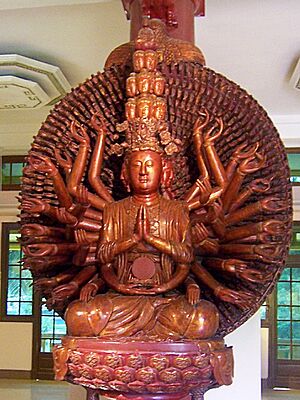
One Chinese legend tells how Guanyin almost emptied hell by helping everyone there. But she saw that many beings were still suffering. Her head split into eleven pieces from trying to understand so much pain. The Buddha Amitābha then gave her eleven heads to help her hear all the cries. When her two arms shattered from trying to reach everyone, Amitābha gave her a thousand arms. This story shows her endless compassion.
Hayagriva Guanyin, also known as "Horse-Headed Guanyin," is a protector of travel. Statues of him are sometimes placed at temple entrances to bless visitors and their vehicles.
Cundī Guanyin is another important form, often shown with eighteen arms holding different tools. She is called the "Mother of the Seventy Million Buddhas." Her mantra is often recited in Chinese Buddhist temples. Cintāmaṇicakra Guanyin, with six arms, holds a wish-granting jewel and a Dharma wheel.
Fishermen in China often pray to Guanyin for safe journeys. This is why she is sometimes called "Guanyin of the Southern Ocean" or "Guanyin of the Island."
Stories of Guanyin
The Story of Princess Miaoshan
One famous story tells of Guanyin's past life as Princess Miaoshan. Her father, King Miaozhuang Wang, was cruel and wanted her to marry a rich man. But Miaoshan wanted to live a religious life and help people. She told her father she would only marry if the marriage could ease the suffering of old age, sickness, and death. When her father got angry, she said only a doctor could do that.
Her father forced her to work hard in a temple, hoping to discourage her. But animals helped her with her chores. The king tried to burn down the temple, but Miaoshan put out the fire with her bare hands, unharmed. Frightened, her father ordered her to be killed.
In one version, when she was killed, a magical tiger took her to a hell-like realm. But instead of suffering, flowers bloomed around her, and she turned the place into a paradise with her compassion. The ruler of hell sent her back to Earth to save his realm from becoming a paradise. She then appeared on Fragrant Mountain.
Another version says Miaoshan willingly let herself die. She took on the bad karma of the executioner who tried to kill her. When she went to the hell-like realms, she saw the suffering there and was filled with sorrow. She used all her good karma to free many souls, turning hell into a paradise. She returned to Earth, vowing never to leave until all suffering ended.
After returning, Guanyin stayed on Mount Putuo for some years, helping sailors and fishermen. This is why she is often seen as their protector.
Guanyin and Shancai
A legend tells of Shancai, a boy from India who was disabled but eager to learn about Buddhism. He traveled to Putuo Island to find Guanyin. Guanyin tested him by creating an illusion of pirates chasing her to a cliff. Shancai, wanting to save his teacher, crawled to the cliff and fell. Guanyin stopped him in mid-air and healed him. From that day, Shancai became her disciple.
Guanyin and Longnü
Years later, a dragon prince was caught by a fisherman. He couldn't turn back into a dragon on land. Guanyin sent Shancai to buy the fish, but a crowd wanted to buy it for immortality. Guanyin's voice echoed, "A life should belong to one who tries to save it, not one who tries to take it." The crowd left, and Shancai returned the fish to the sea.
The Dragon King, grateful, sent his granddaughter, Longnü (dragon girl), to give Guanyin a shining pearl. Longnü was so impressed by Guanyin that she asked to be her disciple. Guanyin accepted, asking Longnü to keep the pearl. Today, Longnü and Shancai are often shown as children beside Guanyin in art.
Guanyin and the Filial Parrot
A story from the Ming Dynasty tells of a smart white parrot who could recite Buddhist texts. When hunters killed its father and blinded its mother, the young parrot was captured while trying to find food. After escaping, it found its mother had died. The parrot mourned and gave her a proper funeral. The Earth God told the parrot to worship Guanyin. Guanyin was so moved by the parrot's devotion to its parents that she allowed them to be reborn in a Pure Land. In art, a white parrot is sometimes seen near Guanyin, holding a pearl or prayer bead, symbolizing devotion.
Guanyin's Role in East Asian Buddhism
In East Asian Buddhism, Guanyin is the Bodhisattva Avalokiteśvara. Chinese Buddhists often call her Guanshiyin Pusa. Even though she is seen as a goddess by many, Buddhists see this as Guanyin's "skillful means" to help people. Buddhist texts say that Bodhisattvas can appear in any form, male or female, to free beings from suffering. This is why Guanyin is sometimes seen as male and sometimes female.
Guanyin is very popular among Chinese Buddhists. She is seen as a source of endless love and a savior. She promised to answer all cries for help and free beings from their problems. Buddhists believe that through her help, even those who seem lost can find enlightenment.
In Mahayana Buddhism, gender doesn't stop someone from reaching enlightenment. The Vimalakirti Sutra shows an enlightened female deity. The Lotus Sutra also tells of a maiden who quickly became enlightened. So, the idea of Avalokiteśvara also being the goddess Guanyin fits Buddhist beliefs. Guanyin is even said to have been a Buddha in the past.
In Pure Land Buddhism, Guanyin is called the "Barque of Salvation." She helps beings move from the cycle of rebirth to the Pure Land, where they can become Buddhas. In art, Guanyin is often shown meditating next to a Buddha, usually Amitābha, and another Bodhisattva.
Even in Buddhist schools that don't focus on devotion, Guanyin is highly respected. She is seen as the very idea of compassion, mercy, and love. Being merciful and loving is seen as being like Guanyin.
The famous Buddhist saying, "Form is emptiness, emptiness is form," comes from the Heart Sutra, which is entirely about Guanyin's teachings.
Guanyin in Other Eastern Religions
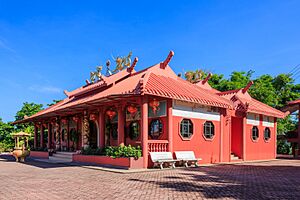
Guanyin is also a very popular goddess in Chinese folk religion and is worshipped in many Chinese communities across Asia. In Taoism, some stories say Guanyin was a Chinese woman who became an immortal.
People love Guanyin for her unconditional love and compassion. She is often seen as the protector of women and children. She is also believed to be a goddess of fertility, helping couples have children. An old Chinese tradition involves a woman offering a shoe to Guanyin when she wants a child. After the child is born, the shoe is returned with a new pair as thanks.
Guanyin is also seen as a champion for those who are unlucky, sick, disabled, or poor. In coastal areas, she is seen as the protector of fishermen and sailors. Some even believe that Mazu, the goddess of the sea, is a form of Guanyin. She is also worshipped as a goddess of farming and agriculture. Some business people see her as a goddess of good fortune.
Guanyin and the Virgin Mary

Some people have noticed similarities between Guanyin and Mary, mother of Jesus. This is because Guanyin is often shown holding a child in Chinese art, especially in her "Child-Sending Guanyin" form. This form is very similar to the Catholic image of the Madonna and Child. For example, a Buddhist organization in Taiwan created a portrait of Guanyin holding a baby that looks like the Virgin Mary.
In Japan, during a time when Christianity was forbidden, some secret Christian groups worshipped Jesus and the Virgin Mary by using statues of Kannon (Guanyin) holding a child. These statues were called Maria Kannon and often had a hidden cross.
Images for kids
-
Shrine to a Tang dynasty (896) carved stone statue of the Thousand-Armed Guanyin (Chinese: Qianshou Guanyin) in Shengshui Temple (內江聖水寺) in Neijiang, Sichuan, China
-
Amoghapāśa Lokesvara (Japanese: Fukūkenjaku Kannon) with devas Brahma and Indra on either side dated to late 8th century) located at Tōdai-ji, Nara, Japan.
-
Chapter 25: The Universal Gateway of Avalokiteśvara Bodhisattva (Published in Edo period)
-
Guanyin as a male bodhisattva. Eleven faced Ekādaśamukha form. Japan, 12th century
-
Chinese porcelain statue depicting Guanyin, Yuan Dynasty (1271–1368 AD)
-
Small shrine to Guanyin or Kannon. Ashikaga, Tochigi, Japan
-
Statue of Ekādaśamukha or the Eleven-Headed Guanyin (Shíyīmiàn Guānyīn) in Bukenqu Guanyin Yard [zh] (不肯去觀音院) in Putuoshan, Zhoushan, Zhejiang Province, China
-
14th century Pāṇḍaravāsinī Avalokiteśvara Bodhisattva, Ming dynasty, Daitokuji temple in Kyoto, Japan
-
Shrine to a statue of Ekādaśamukha, or the Eleven-Headed Guanyin (Shíyīmiàn Guānyīn) in the Drum Tower of Qita Temple (七塔寺) in Yinzhou, Ningbo, Zhejiang Province, China
-
Guanyin statue as pose of The Guanyin of the Southern Seas in Avalokitesvara Buddhist temple at Pematangsiantar, North Sumatra, Indonesia
-
A Chinese Ming dynasty porcelain figure of Guanyin.
-
Shrine to a statue of Ekādaśamukha, or the Eleven-Headed Guanyin (Shíyīmiàn Guānyīn) in Huayan Temple (華嚴寺); Datong, Shanxi Province, China
-
Blessed Virgin Mary, disguised as Kannon, Kakure Kirishitan, 17th century. Salle des Martyrs, Paris Foreign Missions Society.
-
Chinese Madonna. St. Francis' Church, Macao
See also
 In Spanish: Guan Yin para niños
In Spanish: Guan Yin para niños
- Cihang Zhenren, Taoist counterpart of Guanyin
- Kṣitigarbha
- Longnü and Sudhana
- Lotus Sutra
- Manjusri
- Queen Mother of the West
- Samantabhadra
- Tara (Buddhism)
- Saigoku Kannon Pilgrimage
- Mount Putuo, sacred ground of Guanyin
- Quan Âm Pagoda (Ho Chi Minh City), Vietnam
- Cheng Hoon Teng Temple, Malacca, Malaysia
- Kwan Im Thong Hood Cho Temple, Singapore
- Wat Plai Laem, Ko Samui, Thailand
- Lin Fa Temple, Hong Kong
- Kim Tek Ie Temple, Jakarta, Indonesia
- Guanyin of Nanshan, the fourteenth tallest statue in the world
- Tieguanyin, a variety of oolong named after Guanyin



